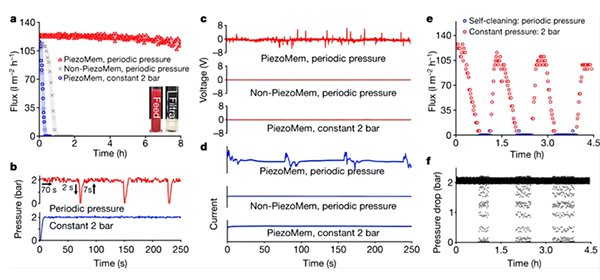
Fig. Piezoelectric effect and fouling reduction induced by hydraulicpressure. Flux (a) under the corresponding time-dependent pressure changes condition (b) and rejection of oil (oil with Oil Red O) (see inset in a). The piezoelectric voltage and current outputs of the membranes in response to hydraulic pressure during filtration (c,d). Fouling first then self-cleaning operation, and flux decay under constant pressure of 2 bar, and recovered (e) by periodic hydraulic pressure cycles (f). Note that the oil content was 2,500 ppm (a,e).
Supported by the National Natural Science Foundation of China (Grant No. 21976085), the research team led by Prof. GAO Guandao from the School of Environment of Nanjing University, in collaboration with domestic and oversea scholars, developed a self-cleaning piezoelectric ceramic membrane (PiezoMem) and designed an anti-fouling method of using the inherent hydraulic pressure in the membrane separation process to generate a piezoelectric voltage on PiezoMem to realize the self-cleaning of the membrane without using external driving force or cleaning agents. The research results were published in Nature on August 3, 2022, titled “Pulsed hydraulic-pressure-responsive self-cleaning membrane”. Here’s the link to the article: http://www.nature.com/articles/s41586-022-04942-4.
The technology of pressure-driven membranes separation is widely used in a range of industries such as water purification, bioprocessing, food processing, and chemical production. Despite their numerous advantages such as high efficiency, modular design, and minimal footprint, inevitable membrane fouling remains a prominent challenge in most practical applications, representing the “Achilles’ heel” of membrane processes.
Herein, a hydraulic pressure responsive membrane (PiezoMem) was designed to transform pressure pulses into electroactive responses for in-situ real-time self-cleaning. A transient hydraulic pressure fluctuation results in PiezoMem generation of considerable current pulses and rapid voltage oscillations (peak, +5.0/-3.2 V) capable of foulant degradation and repulsion without supplementary chemical cleaning agents, secondary waste disposal, or additional external stimuli equipment. PiezoMem exhibited a broad spectrum of anti-fouling action towards a range of membrane foulants, including organic molecules, oil droplets, proteins, bacteria, and inorganic colloids. Reactive oxygen species production and dielectrophoretic repulsion were elucidated to be the underlying antifouling mechanisms. The hybridization of these two mechanisms was observed to result in a universal antifouling process independent of specific foulant nature. This shows advantages over the traditional regulation of membrane surface charge that typically relies on electrostatic repulsive forces that are only effective on colloids of one particular charge, and is attractive and more adhesive to colloids of the opposite charge. Therefore, the pulsed PiezoMem dielectrophoretic antifouling mechanism discovered here can be used to guide universal antifouling membrane design and application.
By integrating the antifouling with the membrane separation process, PiezoMem realizes self-cleaning without supplementary chemical cleaning agents or additional external stimuli equipment, demonstrating advantages and potential for wide applications compared with traditional membranes.

Add: 83 Shuangqing Rd., Haidian District, Beijing, China
Postcode: 100085
Tel: 86-10-62327001
Fax: 86-10-62327004
E-mail: bic@donnasnhdiary.org
京ICP备05002826号 文保网安备1101080035号 Copyright 2017 NSFC, All Right Reserved